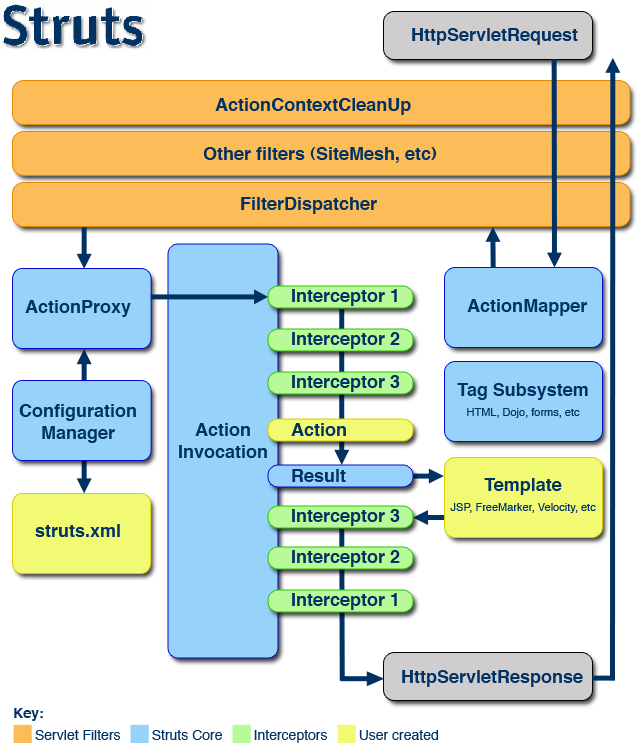什么是Struts2
Struts2是一个基于MVC设计模式的Web应用框架,它本质上相当于一个servlet,在MVC设计模式中,Struts2作为控制器(Controller)来建立模型与视图的数据交互。
时序图
流程图
这部分来自于博客:http://blog.csdn.net/ichsonx/article/details/2954397
非常感谢

一个请求在Struts2框架中的处理大概分为以下几个步骤:
1.客户端提起一个(HttpServletRequest)请求,如上文在浏览器中输入”http://localhost:8080/TestMvc/add.action”就是提起一个(HttpServletRequest)请求。
2.请求被提交到一系列(主要是三层)的过滤器(Filter),如(ActionContextCleanUp、其他过滤器(SiteMesh等)、 FilterDispatcher)。注意这里是有顺序的,先ActionContextCleanUp,再其他过滤器(SiteMesh等)、最后到FilterDispatcher。
3.FilterDispatcher是控制器的核心,就是mvc中c控制层的核心。下面粗略的分析下我理解的FilterDispatcher工作流程和原理:FilterDispatcher进行初始化并启用核心doFilter
public void doFilter(ServletRequest req, ServletResponse res, FilterChain chain) throws IOException, ServletException ...{
HttpServletRequest request = (HttpServletRequest) req;
HttpServletResponse response = (HttpServletResponse) res;
ServletContext servletContext = filterConfig.getServletContext();
// 在这里处理了HttpServletRequest和HttpServletResponse。
DispatcherUtils du = DispatcherUtils.getInstance();
du.prepare(request, response);//正如这个方法名字一样进行locale、encoding以及特殊request parameters设置
try ...{
request = du.wrapRequest(request, servletContext);//对request进行包装
} catch (IOException e) ...{
String message = "Could not wrap servlet request with MultipartRequestWrapper!";
LOG.error(message, e);
throw new ServletException(message, e);
}
ActionMapperIF mapper = ActionMapperFactory.getMapper();//得到action的mapper
ActionMapping mapping = mapper.getMapping(request);// 得到action 的 mapping
if (mapping == null) ...{
// there is no action in this request, should we look for a static resource?
String resourcePath = RequestUtils.getServletPath(request);
if ("".equals(resourcePath) && null != request.getPathInfo()) ...{
resourcePath = request.getPathInfo();
}
if ("true".equals(Configuration.get(WebWorkConstants.WEBWORK_SERVE_STATIC_CONTENT))
&& resourcePath.startsWith("/webwork")) ...{
String name = resourcePath.substring("/webwork".length());
findStaticResource(name, response);
} else ...{
// this is a normal request, let it pass through
chain.doFilter(request, response);
}
// WW did its job here
return;
}
Object o = null;
try ...{
//setupContainer(request);
o = beforeActionInvocation(request, servletContext);
//整个框架最最核心的方法,下面分析
du.serviceAction(request, response, servletContext, mapping);
} finally ...{
afterActionInvocation(request, servletContext, o);
ActionContext.setContext(null);
}
}
du.serviceAction(request, response, servletContext, mapping);
//这个方法询问ActionMapper是否需要调用某个Action来处理这个(request)请求,如果ActionMapper决定需要调用某个Action,FilterDispatcher把请求的处理交给ActionProxy
public void serviceAction(HttpServletRequest request, HttpServletResponse response, String namespace, String actionName, Map requestMap, Map parameterMap, Map sessionMap, Map applicationMap) ...{
HashMap extraContext = createContextMap(requestMap, parameterMap, sessionMap, applicationMap, request, response, getServletConfig()); //实例化Map请求 ,询问ActionMapper是否需要调用某个Action来处理这个(request)请求
extraContext.put(SERVLET_DISPATCHER, this);
OgnlValueStack stack = (OgnlValueStack) request.getAttribute(ServletActionContext.WEBWORK_VALUESTACK_KEY);
if (stack != null) ...{
extraContext.put(ActionContext.VALUE_STACK,new OgnlValueStack(stack));
}
try ...{
ActionProxy proxy = ActionProxyFactory.getFactory().createActionProxy(namespace, actionName, extraContext);
//这里actionName是通过两道getActionName解析出来的, FilterDispatcher把请求的处理交给ActionProxy,下面是ServletDispatcher的 TODO:
request.setAttribute(ServletActionContext.WEBWORK_VALUESTACK_KEY, proxy.getInvocation().getStack());
proxy.execute();
//通过代理模式执行ActionProxy
if (stack != null)...{
request.setAttribute(ServletActionContext.WEBWORK_VALUESTACK_KEY,stack);
}
} catch (ConfigurationException e) ...{
log.error("Could not find action", e);
sendError(request, response, HttpServletResponse.SC_NOT_FOUND, e);
} catch (Exception e) ...{
log.error("Could not execute action", e);
sendError(request, response, HttpServletResponse.SC_INTERNAL_SERVER_ERROR, e);
}
} FilterDispatcher询问ActionMapper是否需要调用某个Action来处理这个(request)请求,如果ActionMapper决定需要调用某个Action,FilterDispatcher把请求的处理交给ActionProxy。
4.ActionProxy通过Configuration Manager(struts.xml)询问框架的配置文件,找到需要调用的Action类.
如上文的struts.xml配置
<?xml version="1.0" encoding="GBK"?>
<!DOCTYPE struts PUBLIC "-//Apache Software Foundation//DTD Struts Configuration 2.0//EN" "http://struts.apache.org/dtds/struts-2.0.dtd">
<struts>
<include file="struts-default.xml"/>
<package name="struts2" extends="struts-default">
<action name="add"
class="edisundong.AddAction" >
<result>add.jsp</result>
</action>
</package>
</struts>如果提交请求的是add.action,那么找到的Action类就是edisundong.AddAction。
5.ActionProxy创建一个ActionInvocation的实例,同时ActionInvocation通过代理模式调用Action。但在调用之前ActionInvocation会根据配置加载Action相关的所有Interceptor。(Interceptor是struts2另一个核心级的概念)
下面我们来看看ActionInvocation是如何工作的:
ActionInvocation 是Xworks 中Action 调度的核心。而对Interceptor 的调度,也正是由ActionInvocation负责。ActionInvocation 是一个接口, 而DefaultActionInvocation 则是Webwork 对ActionInvocation的默认实现。
Interceptor 的调度流程大致如下:
1. ActionInvocation初始化时,根据配置,加载Action相关的所有Interceptor。
2. 通过ActionInvocation.invoke方法调用Action实现时,执行Interceptor。
Interceptor将很多功能从我们的Action中独立出来,大量减少了我们Action的代码,独立出来的行为具有很好的重用性。XWork、WebWork的许多功能都是有Interceptor实现,可以在配置文件中组装Action用到的Interceptor,它会按照你指定的顺序,在Action执行前后运行。
那么什么是拦截器。
拦截器就是AOP(Aspect-Oriented Programming)的一种实现。(AOP是指用于在某个方法或字段被访问之前,进行拦截然后在之前或之后加入某些操作。)
一旦Action执行完毕,ActionInvocation负责根据struts.xml中的配置找到对应的返回结果。如上文中将结构返回“add.jsp”,但大部分时候都是返回另外一个action,那么流程又得走一遍。
标准返回值
-ActionSupport基类中定义了五个标准的返回值 ,当然我们可以自己随意定义返回的名字
- String SUCCESS = “success”; //默认是 SUCCESS 类型
- String NONE = “none”;
- String ERROR = “error”;
- String INPUT = “input”;
- String LOGIN = “login”;
基础配置
依赖的jar包
这些jar包是我自己写项目中都有用到的
- aopalliance-1.0.jar 这个包为AOP提供了最普通和通用的接口
- commons-collections-3.1.jar 包含了一些Apache开发的集合类,扩展了标准的Java Collection框架,提供了额外的Map、List 和Set实现以及多个有用的工具类库。功能比java.util.*强大。
- commons-fileupload-1.3.1.jar Struts文件的上传下载
- commons-io-2.2.jar Commons项目中用来处理IO的一些工具类包
- commons-lang3-3.2.jar 为java.lang包提供扩展
- commons-logging-1.1.3.jar Jakarta的通用日志记录包
- freemarker-2.3.22.jar FreeMarker是一个模板引擎,一个基于模板生成文本输出的通用工具
- javassist-3.11.0.GA.jar 编辑Java字节码的类库
- ognl-3.0.6.jar 支持ognl表达式
- struts2-convention-plugin-2.3.24.1.jar 在默认情况下该公约插件查找操作类在以下软件包支柱,struts2的行为或行动,任何包相匹配这些名称将被考虑作为根包为常规插件。
- struts2-core-2.3.24.1.jar struts2的核心包
- struts2-spring-plugin-2.3.24.1.jar struts2和spring整合需要的包
- xwork-core-2.3.24.1.jar xwork核心包
- struts2-json-plugin-2.3.24.1.jar struts2 结合ajax时使用json数据格式的jar包
web.xml
<!-- struts启动配置 -->
<filter>
<filter-name>struts2</filter-name>
<filter-class>org.apache.struts2.dispatcher.ng.filter.StrutsPrepareAndExecuteFilter</filter-class>
</filter>
<filter-mapping>
<filter-name>struts2</filter-name>
<url-pattern>/*</url-pattern>
</filter-mapping>struts.xml
<?xml version="1.0" encoding="UTF-8" ?>
<!DOCTYPE struts PUBLIC
"-//Apache Software Foundation//DTD Struts Configuration 2.3//EN"
"http://struts.apache.org/dtds/struts-2.3.dtd">
<struts>
<!-- 请求参数的编码方式 -->
<constant name="struts.i18n.encoding" value="UTF-8"/>
<!-- 指定被struts2处理的请求后缀类型。多个用逗号隔开 -->
<constant name="struts.action.extension" value="action,do,go"/>
<!-- 当struts.xml改动后,是否重新加载。默认值为false(生产环境下使用),开发阶段最好打开 -->
<constant name="struts.configuration.xml.reload" value="true"/>
<!-- 是否使用struts的开发模式。开发模式会有更多的调试信息。默认值为false(生产环境下使用),开发阶段最好打开 -->
<constant name="struts.devMode" value="false"/>
<!-- 设置浏览器是否缓存静态内容。默认值为true(生产环境下使用),开发阶段最好关闭 -->
<constant name="struts.serve.static.browserCache" value="false" />
<!-- 指定由spring负责action对象的创建 -->
<constant name="struts.objectFactory" value="spring" />
<!-- 指定上传文件临时文件的位置 -->
<constant name="struts.multipart.saveDir" value="/Users/wangjian/Downloads/upload/tmp/"/>
<!-- 指定上传文件的最大size -->
<constant name="struts.multipart.maxSize" value="9000000"/>
<!-- 是否开启动态方法调用 -->
<constant name="struts.enable.DynamicMethodInvocation" value="true"/>
<!-- 全局异常处理 -->
<package name="commonPkg" extends="struts-default" abstract="true" >
<global-results>
<result name="error">/common/error404.jsp</result>
</global-results>
<global-exception-mappings>
<exception-mapping result="error" exception="java.lang.Exception" />
<exception-mapping result="error" exception="java.sql.SQLException" />
</global-exception-mappings>
</package>
</struts>





















 283
283

 被折叠的 条评论
为什么被折叠?
被折叠的 条评论
为什么被折叠?








